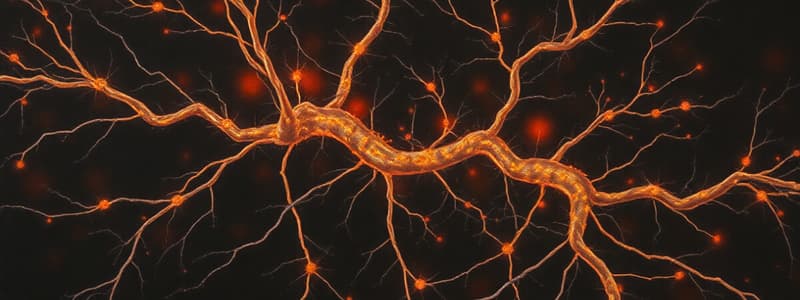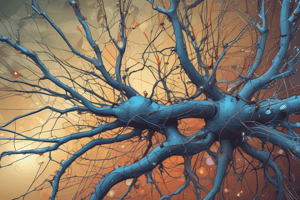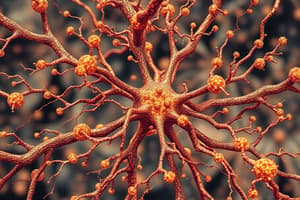Podcast
Questions and Answers
What is the term for the process that can selectively alter the effectiveness of a presynaptic input?
What is the term for the process that can selectively alter the effectiveness of a presynaptic input?
- Postsynaptic excitation
- Temporal Summation
- Presynaptic inhibition (correct)
- Spatial Summation
Which mechanism involves the summation of multiple signals at a synapse?
Which mechanism involves the summation of multiple signals at a synapse?
- Temporal Summation
- Signal Disruption
- Presynaptic facilitation
- Spatial Summation (correct)
How does presynaptic facilitation affect synaptic transmission?
How does presynaptic facilitation affect synaptic transmission?
- It has no effect on neurotransmitter transmission
- It alters the postsynaptic receptor sensitivity
- It enhances neurotransmitter release (correct)
- It decreases neurotransmitter release
What is a primary role of presynaptic inhibition in neural communication?
What is a primary role of presynaptic inhibition in neural communication?
Which option best describes the relationship between spatial summation and presynaptic mechanisms?
Which option best describes the relationship between spatial summation and presynaptic mechanisms?
What connects two neurons in an electrical synapse?
What connects two neurons in an electrical synapse?
Which statement about electrical synapses is correct?
Which statement about electrical synapses is correct?
Which type of synapse transmits chemical messengers?
Which type of synapse transmits chemical messengers?
What characterizes electrical synapses compared to chemical synapses?
What characterizes electrical synapses compared to chemical synapses?
What role do gap junctions play in electrical synapses?
What role do gap junctions play in electrical synapses?
What effect does an excitatory postsynaptic potential (EPSP) have on the postsynaptic cell membrane?
What effect does an excitatory postsynaptic potential (EPSP) have on the postsynaptic cell membrane?
Which channels, when opened by a neurotransmitter, lead to hyperpolarization in an inhibitory postsynaptic potential (IPSP)?
Which channels, when opened by a neurotransmitter, lead to hyperpolarization in an inhibitory postsynaptic potential (IPSP)?
How do EPSP and IPSP differ in their effects on postsynaptic neuron activity?
How do EPSP and IPSP differ in their effects on postsynaptic neuron activity?
What are the graded potentials in postsynaptic potentials referred to?
What are the graded potentials in postsynaptic potentials referred to?
Which of the following describes the basic mechanism of an EPSP?
Which of the following describes the basic mechanism of an EPSP?
What is the main role of excitatory post-synaptic potentials (EPSPs)?
What is the main role of excitatory post-synaptic potentials (EPSPs)?
What distinguishes inhibitory post-synaptic potentials (IPSPs) from EPSPs?
What distinguishes inhibitory post-synaptic potentials (IPSPs) from EPSPs?
What occurs at the synapse between two neurons?
What occurs at the synapse between two neurons?
Which of the following is NOT a structure a neuron may terminate on?
Which of the following is NOT a structure a neuron may terminate on?
Which statement accurately describes synaptic transmission?
Which statement accurately describes synaptic transmission?
What does convergence input refer to in the context of neuron activity?
What does convergence input refer to in the context of neuron activity?
Which of the following best describes divergence in neural communication?
Which of the following best describes divergence in neural communication?
How does convergence affect the signaling capacity of a neuron?
How does convergence affect the signaling capacity of a neuron?
In terms of neural networks, what is the relationship between convergence and divergence?
In terms of neural networks, what is the relationship between convergence and divergence?
What is a likely consequence of high levels of convergence on a neuron's function?
What is a likely consequence of high levels of convergence on a neuron's function?
Which of the following is an example of an electrical synapse?
Which of the following is an example of an electrical synapse?
What type of synapse predominates in the human central nervous system?
What type of synapse predominates in the human central nervous system?
Which type of muscle is associated with electrical synapses?
Which type of muscle is associated with electrical synapses?
What is the primary function of chemical synapses in the human nervous system?
What is the primary function of chemical synapses in the human nervous system?
Which statement accurately reflects the characteristics of electrical synapses?
Which statement accurately reflects the characteristics of electrical synapses?
What is a primary outcome when presynaptic input undergoes facilitation?
What is a primary outcome when presynaptic input undergoes facilitation?
Which statement accurately describes the difference between EPSP and IPSP?
Which statement accurately describes the difference between EPSP and IPSP?
What defines the role of gap junctions in electrical synapses?
What defines the role of gap junctions in electrical synapses?
Which of the following best describes 'convergence' in neural communication?
Which of the following best describes 'convergence' in neural communication?
What is the typical effect of an increase in synaptic transmission on postsynaptic neuron activity?
What is the typical effect of an increase in synaptic transmission on postsynaptic neuron activity?
What defines synaptic transmission?
What defines synaptic transmission?
Which type of synapse involves direct electrical coupling between neurons?
Which type of synapse involves direct electrical coupling between neurons?
What is a characteristic feature of chemical synapses?
What is a characteristic feature of chemical synapses?
Which mechanism is essential for neurotransmitter release at a chemical synapse?
Which mechanism is essential for neurotransmitter release at a chemical synapse?
What distinguishes electrical synapses from chemical synapses?
What distinguishes electrical synapses from chemical synapses?
Study Notes
Synapses and Neuronal Integration
- Synapses occur between two neurons where communication occurs
- There are two types of synapses: Electrical and Chemical
Electrical Synapses
- Two neurons connected by gap junctions
- Gap junctions allow ions to flow freely between the two cells
- Postsynaptic potentials are graded potentials, not action potentials
Chemical Synapses
- Chemical messengers are transmitted across the junction separating two neurons
Excitatory Postsynaptic Potential (EPSP)
- EPSPs depolarize the postsynaptic cell membrane
- The neurotransmitter stimulates the opening of sodium or calcium channels
Inhibitory Postsynaptic Potential (IPSP)
- IPSPs hyperpolarize the postsynaptic cell membrane
- The neurotransmitter stimulates the opening of chloride or potassium channels
Spatial Summation
- A single neuron receives simultaneous input from multiple presynaptic neurons
- Allows for the integration of multiple signals at the postsynaptic neuron
Presynaptic Inhibition or Facilitation
- Can selectively alter the effectiveness of a presynaptic input
Convergence
- Thousands of other neurons can influence a single neuron due to convergence input
Divergence
- A single neuron can synapse with many other cells due to the branching of axon terminals
Synaptic Transmission
- Synaptic transmission is the process of information transfer from one neuron to another.
- There are two main types of synapses: electrical and chemical.
Electrical Synapses
- In electrical synapses, the cytoplasm of two adjacent neurons is connected by gap junctions.
- Gap junctions allow for direct flow of electrical current from one neuron to another, enabling fast and synchronized communication.
- Electrical synapses are relatively rare in the human nervous system, but they are important for functions like:
- Pulp of the tooth
- Retina of the eye
- Cardiac muscle
- Smooth muscle
Chemical Synapses
- Chemical synapses are the most common type of synapse in the human central nervous system (CNS).
- In chemical synapses, information is transmitted through the release of chemical messengers called neurotransmitters.
- Neurotransmitters are released from the presynaptic neuron and bind to receptors on the postsynaptic neuron, triggering a response.
Neurotransmitter Removal
- After release, neurotransmitters are rapidly removed from the synaptic cleft to prevent prolonged signaling.
- There are several mechanisms for neurotransmitter removal:
- Inactivation by enzymes: Enzymes on the postsynaptic membrane break down neurotransmitters.
- Diffusion: Neurotransmitters simply diffuse away from the synaptic cleft.
- Reuptake: Neurotransmitters are actively transported back into the presynaptic axon terminal.
Excitatory and Inhibitory Neurotransmitters
- The most common excitatory neurotransmitter in the brain is glutamate.
- The most common inhibitory neurotransmitter in the brain is GABA (gamma-aminobutyric acid).
Studying That Suits You
Use AI to generate personalized quizzes and flashcards to suit your learning preferences.
Related Documents
Description
This quiz covers the essential concepts of synapses and neuronal integration, including the differences between electrical and chemical synapses. It explores excitatory and inhibitory postsynaptic potentials, as well as spatial summation. Test your understanding of how neurons communicate and integrate signals.





